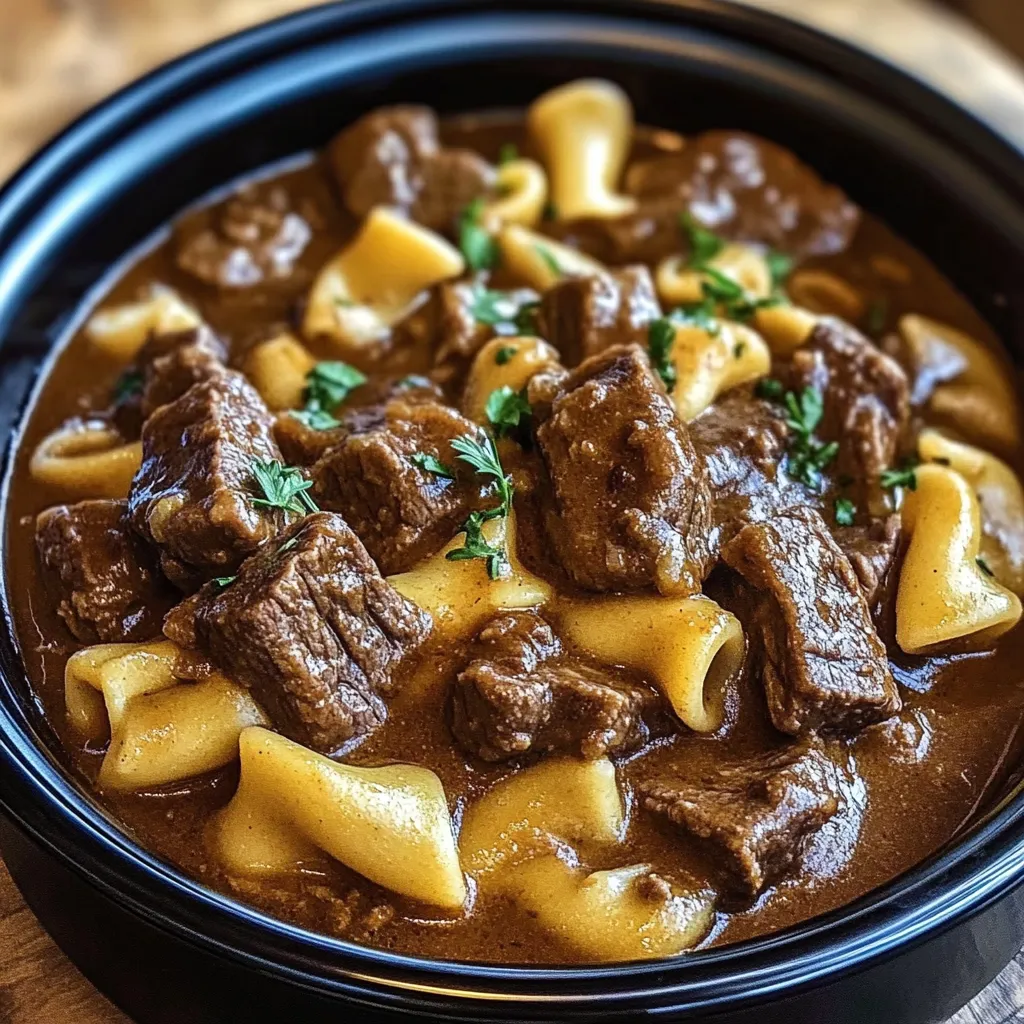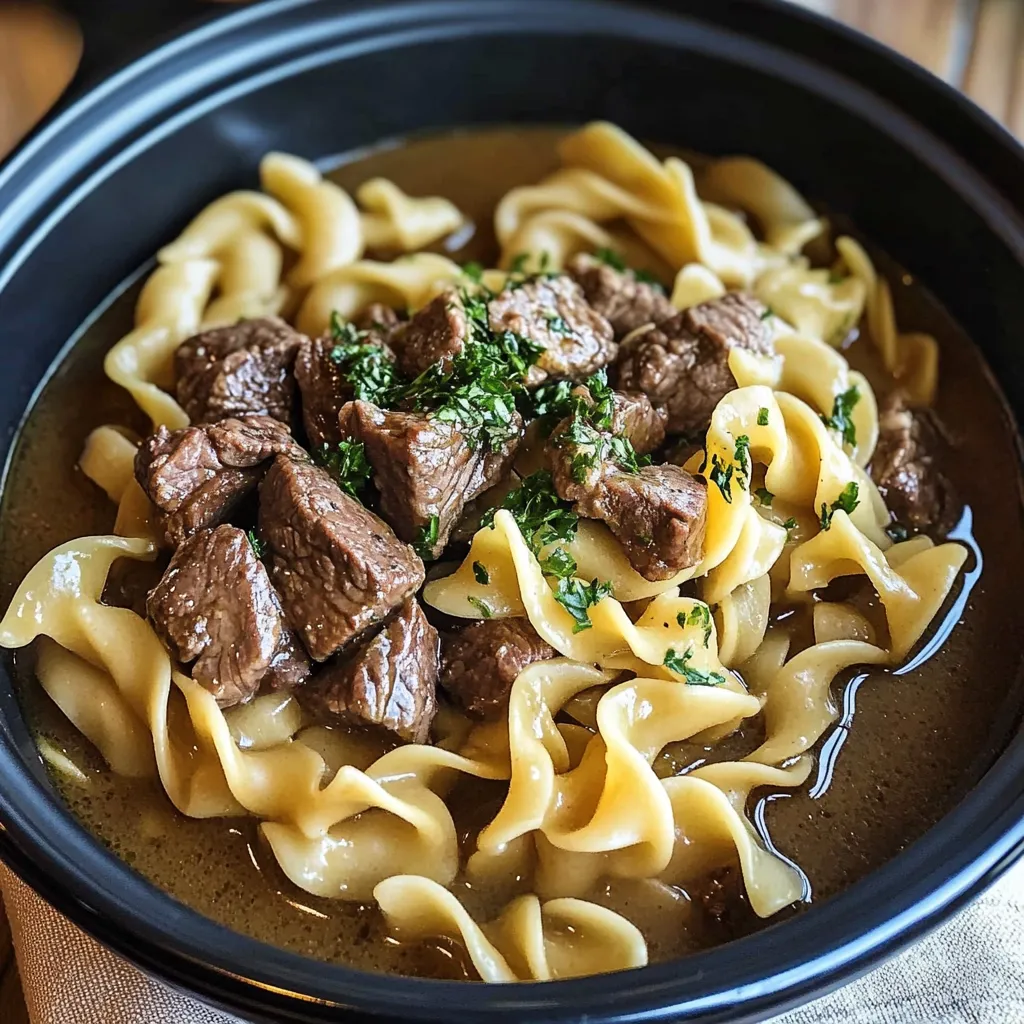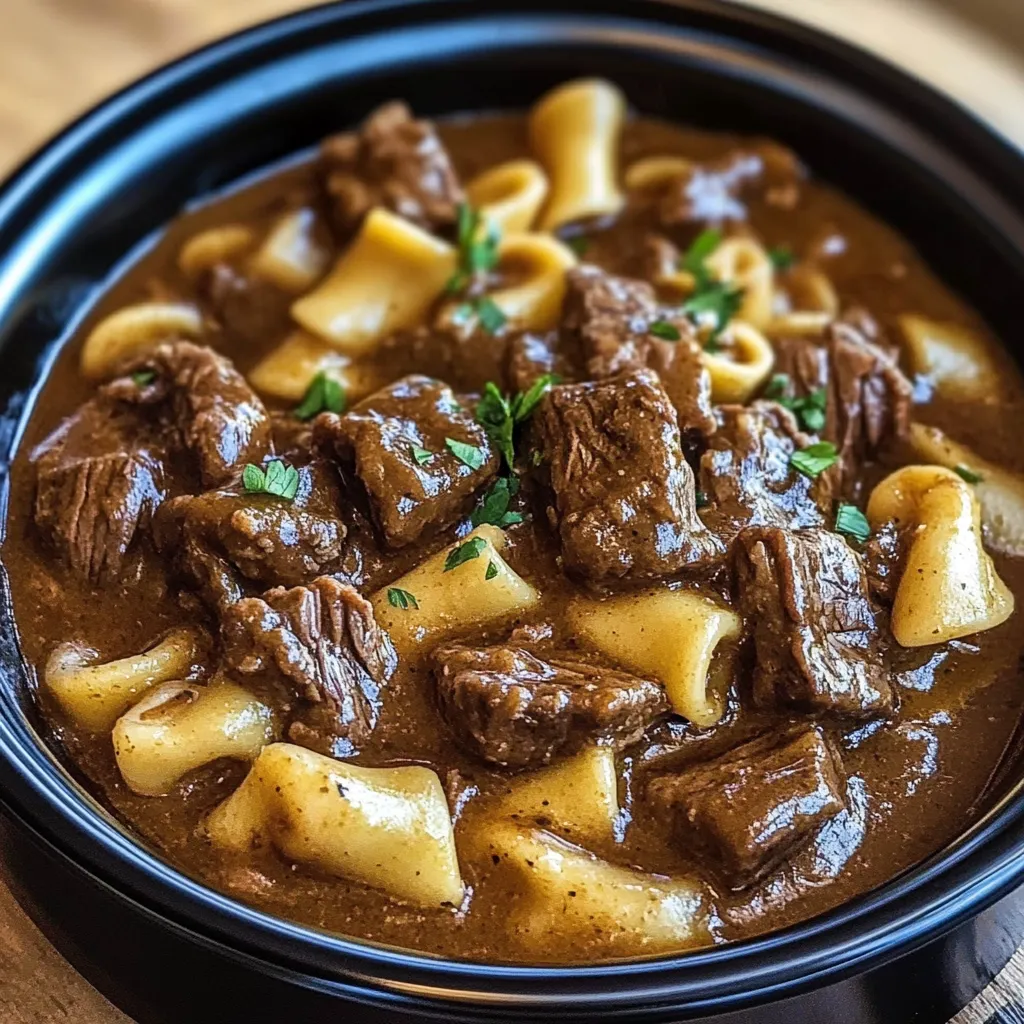 Save
Save
Succulent beef surrenders to time while creating its own rich sauce that embraces tender egg noodles in a symphony of comforting flavors and textures. This Slow Cooker Beef and Noodles transforms humble ingredients into an extraordinary dining experience through the patience of slow cooking and thoughtful technique. Each spoonful delivers fork-tender beef and silken noodles suspended in a velvety broth—creating a dish that nurtures body and spirit alike, perfect for days when both sustenance and solace are required.
I discovered this soul-satisfying combination during a particularly harsh winter when I craved something that would warm us from the inside out. The first time I lifted the slow cooker lid after hours of patient cooking, the fragrance alone triggered an almost visceral memory of Sunday dinners at my grandmother's table. My husband, typically reserved with his praise, closed his eyes upon tasting and simply said, 'This tastes like coming home.' What began as practical cold-weather nourishment has evolved into our most-requested family comfort meal, appearing at our table whenever someone needs the culinary equivalent of a warm embrace.
Comforting Foundations
- Beef chuck roast: Ideal marbling creates exceptional tenderness; well-trimmed provides cleaner flavor
- All-purpose flour: Creates subtle thickening foundation; helps develop beautiful browning on meat
- Vegetable oil: Neutral flavor allows beef to shine; high smoke point prevents burning during searing
- Yellow onion: Provides aromatic sweetness when caramelized; larger dice maintains presence throughout cooking
- Garlic: Fresh cloves deliver aromatic depth; minced size releases maximum flavor
- Beef broth: Homemade offers superior flavor complexity; low-sodium varieties allow better seasoning control
- Mushrooms: Cremini varieties offer deeper flavor than white button; wild mushrooms elevate even further
- Dried thyme: Earthy, warm notes complement beef beautifully; maintains presence during extended cooking
- Dried parsley: Adds subtle herbaceous notes and color; fresh varieties reserved for finishing
- Egg noodles: Wide varieties withstand slow cooking; extra-wide create more substantial texture
- Salt and pepper: Kosher salt and freshly cracked pepper allow precise seasoning development
Culinary Creation
- Meat Preparation
- Begin with properly trimmed chuck roast, cutting against the grain into generous cubes approximately 1½ inches in size. This specific dimension ensures the meat maintains structural integrity throughout extended cooking while still becoming fork-tender. Pat the cubes thoroughly dry with paper towels—this essential step removes surface moisture that would otherwise inhibit proper browning. In a shallow bowl, combine flour, salt, and pepper, then toss the beef cubes until lightly but evenly coated. This dredging not only seasons the meat but creates a subtle thickening agent for the sauce and promotes exceptional browning.
- Foundational Flavor
- Heat vegetable oil in a large, heavy-bottomed skillet until shimmering but not smoking. Working in small batches to prevent overcrowding, arrange the flour-dusted beef cubes in a single layer, allowing them to develop a rich golden-brown crust before turning. This patient browning process is perhaps the most crucial step in the entire recipe, creating profound flavor through Maillard reactions that elevate the final dish immeasurably. Transfer each batch to the slow cooker as completed, preserving all those valuable flavor particles in the skillet for the next step.
- Aromatic Development
- In the same skillet still containing beef fond and remaining oil, add chopped onions, allowing them to soften and begin caramelizing—a process that converts their sharp pungency into delectable sweetness. As they approach translucency, add minced garlic, stirring constantly for thirty seconds until fragrant but not browned, which would introduce unwanted bitterness. This aromatic foundation contributes essential depth to the final dish. Transfer this mixture to the slow cooker, using a wooden spoon to scrape up any browned bits from the skillet bottom—these contain concentrated flavor that would be tragic to waste.
- Slow Transformation
- Add beef broth, sliced mushrooms, and dried thyme to the slow cooker, stirring gently to combine all elements while being careful not to dislodge the precious brown crust on the meat pieces. Cover and set to HIGH, allowing the contents to simmer undisturbed for approximately four hours. During this extended cooking period, something magical happens—tough connective tissues in the beef break down, releasing gelatin that enriches the broth while the meat itself becomes extraordinarily tender. Meanwhile, the mushrooms release their earthy essence, creating a sauce with remarkable complexity that belies its simple ingredients.
- Noodle Integration
- Once the beef reaches perfect tenderness—yielding effortlessly when pressed with a fork—add the egg noodles and dried parsley directly to the slow cooker, stirring gently to submerge them in the rich broth. Reduce heat to LOW and continue cooking for approximately 30 minutes until the noodles reach ideal tenderness. This direct cooking method allows the pasta to absorb the intensely flavored liquid, becoming infused with beefiness rather than merely coated with sauce. After cooking, allow the dish to rest for 5-10 minutes before serving, which permits the sauce to thicken slightly while flavors settle into perfect harmony.
 Save
Save
My grandmother always insisted that 'true comfort food shouldn't just fill the stomach but should nourish the spirit,' and this slow-cooked creation embodies her wisdom perfectly. I'll never forget serving it to a dear friend going through a difficult time who took one bite, sighed deeply, and said, 'I didn't realize how much I needed exactly this.' Her simple reaction confirmed what I'd discovered myself—that sometimes our deepest food memories connect to moments of feeling cared for, and recreating those dishes becomes a way of extending that same care to others. The magic of this particular recipe lies not in technical complexity but in how it transforms ordinary ingredients through patient cooking into something that satisfies on multiple levels.
Thoughtful Serving
This hearty dish welcomes thoughtful presentation that enhances its comforting nature. Serve in wide, shallow bowls that showcase the generous pieces of beef while containing the rich broth. A light dusting of freshly chopped parsley adds vibrant color contrast against the deeper hues of the beef and sauce. For family-style serving, present in a large, warmed tureen that maintains proper temperature throughout the meal. Consider offering crusty artisan bread alongside for capturing every drop of the magnificent sauce. For more formal occasions, individual portions can be garnished with a small sprig of fresh thyme and a delicate swirl of sour cream that slowly melts into the broth, creating beautiful visual appeal.
Creative Variations
Transform this adaptable recipe to accommodate seasonal availability and personal preferences. Winter variations shine with the addition of root vegetables like carrots and parsnips. Spring adaptations might incorporate young peas in the final minutes of cooking. For deeper mushroom presence, reconstitute dried porcini and add both the mushrooms and their strained soaking liquid to the broth. Wine enthusiasts might deglaze the browning pan with a splash of red wine before adding onions. Those seeking Hungarian influence could incorporate sweet paprika and a dollop of sour cream at serving. For special dietary needs, consider alternative noodle options like egg-free varieties or even zucchini ribbons for lower carbohydrate requirements.
Practical Preservation
Store leftovers properly to maintain quality for several days of continued enjoyment. Allow the dish to cool completely before transferring to airtight containers, which prevents condensation that would dilute the rich flavors. Refrigerate for up to four days, knowing the flavors often continue developing overnight as the noodles absorb more of the sauce. Reheat gently on the stovetop or in a microwave at 70% power, adding a splash of beef broth if the mixture has thickened too much during storage. For longer preservation, consider freezing the beef and sauce without noodles for up to three months, then adding freshly cooked pasta when reheating for optimal texture.
 Save
Save
The first time I prepared this Slow Cooker Beef and Noodles, I was simply seeking a practical way to create a satisfying meal despite a demanding schedule. What I discovered was a dish that delivers more comfort and satisfaction than its straightforward preparation might suggest. Each time I make it, I'm reminded that cooking at its most meaningful is about transformation—not just of ingredients into something delicious, but of ordinary moments into opportunities for connection. The way tough meat surrenders to time becoming incredibly tender, how simple aromatics develop profound depth, and the beautiful alchemy that occurs when separate elements meld into something greater than their individual potential—these elements combine to create something that feels like culinary magic, even on the most ordinary Tuesday.
Common Questions About Cooking
- → Can I use a different cut of beef?
- While chuck roast is ideal for its marbling and how it breaks down during slow cooking, you can substitute it with bottom round, brisket, or even short ribs for this recipe. Each will provide slightly different textures and flavors. Leaner cuts like sirloin can work but may not be as tender or flavorful. Avoid cuts like tenderloin or ribeye, which are too expensive and would be wasted in a slow cooker.
- → What if I don't have time to brown the meat?
- While browning the meat adds significant depth of flavor through the Maillard reaction, you can skip this step if you're short on time. The dish will still be good, just not as rich and complex in flavor. If skipping, increase the seasonings slightly and consider adding 1-2 tablespoons of Worcestershire sauce or a tablespoon of tomato paste to the slow cooker to help develop deeper flavors.
- → Can I cook this on LOW instead of HIGH?
- Yes, you can cook this on the LOW setting for 7-8 hours instead of HIGH for 4 hours. The beef will become even more tender, which is ideal if you're starting it in the morning before work. Just add the noodles during the last 30-45 minutes of cooking time, turning the heat to HIGH for that final period to ensure they cook properly.
- → How do I prevent my noodles from getting mushy?
- To prevent mushy noodles, make sure to add them only during the last 30 minutes of cooking time. Check them at the 20-minute mark - they should be al dente, as they'll continue to absorb liquid and soften while resting. You can also cook the noodles separately and add them just before serving, though they won't absorb as much of the flavorful broth this way.
- → Can I make this recipe gluten-free?
- Yes, to make this recipe gluten-free, replace the all-purpose flour with a gluten-free flour blend or cornstarch for dredging the beef. Use gluten-free beef broth (always check labels) and substitute the egg noodles with gluten-free pasta such as rice noodles or gluten-free egg noodles. Add the gluten-free noodles during the last 15-20 minutes of cooking, as they often cook faster than traditional egg noodles.
- → What side dishes pair well with beef and noodles?
- This hearty dish pairs well with simple sides that complement without overwhelming. Try a crisp green salad with vinaigrette, steamed or roasted green vegetables like broccoli or green beans, glazed carrots, or a simple cucumber salad. For bread, consider dinner rolls, crusty bread, or biscuits for sopping up the delicious sauce. For a traditional Midwestern meal, serve with applesauce or pickled beets on the side.
